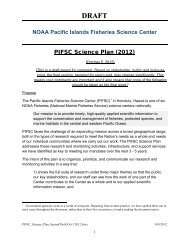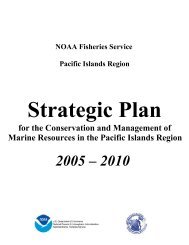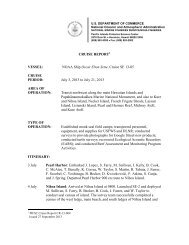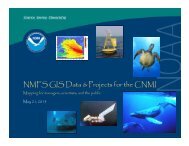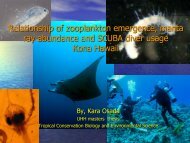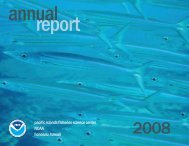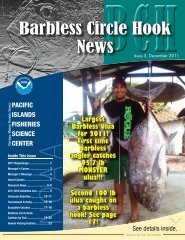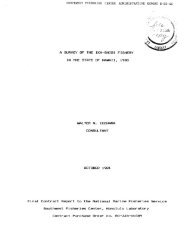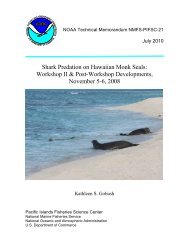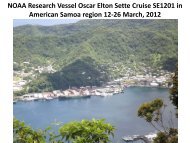Contingency Plan for Hawaiian Monk Seal Unusual Mortality Events
Contingency Plan for Hawaiian Monk Seal Unusual Mortality Events
Contingency Plan for Hawaiian Monk Seal Unusual Mortality Events
Create successful ePaper yourself
Turn your PDF publications into a flip-book with our unique Google optimized e-Paper software.
6<br />
independence (Antonelis et al., 2001). High juvenile mortality was also observed in 2002<br />
(NMFS unpublished data).<br />
1.5 Background of this Document<br />
The first attempt to develop a response plan <strong>for</strong> UMEs in <strong>Hawaiian</strong> monk seals is<br />
presented by Gilmartin (1987). The National Marine Fisheries Service (NMFS) has<br />
published a National <strong>Contingency</strong> <strong>Plan</strong> <strong>for</strong> responding to unusual marine mammal<br />
mortality events (Wilkinson, 1996). The WGUMMME recommended that a separate<br />
plan, consistent with the national plan and other relevant documents such as the Hawaii<br />
Area Oil Spill <strong>Contingency</strong> <strong>Plan</strong>, be prepared <strong>for</strong> <strong>Hawaiian</strong> monk seals because of their<br />
endangered status and the logistic difficulties associated with the remoteness of most of<br />
their colonies. A separate plan was prepared <strong>for</strong> manatees by Geraci and Lounsbury<br />
(1997), and the <strong>Hawaiian</strong> monk seal contingency plan follows the manatee <strong>for</strong>mat.<br />
2. Federal/State Authority and Jurisdiction<br />
The Marine Mammal Health and Stranding Response Act was passed by the U.S.<br />
Congress in 1992 (P.L. 102-587, 16 U.S.C. 1421 [c-d]), and it became Title IV of the<br />
Marine Mammal Protection Act (MMPA). Section 404 of MMPA Title 4 (P.L. 103-238,<br />
§24(b)(1)) established a framework <strong>for</strong> responding to Marine Mammal UMEs, described<br />
in detail in the National <strong>Contingency</strong> <strong>Plan</strong> <strong>for</strong> Response to <strong>Unusual</strong> Marine Mammal<br />
<strong>Mortality</strong> <strong>Events</strong> (Wilkinson, 1996). The response sequence is outlined below and is<br />
presented as a flowchart in Appendix I-1.<br />
• An increase in stranding rates or unusual findings is detected through one of three<br />
likely mechanisms:<br />
o NMFS Regional Stranding Coordinator (Pacific Islands Regional Office,<br />
PIRO) detects increased strandings or unusual findings upon reviewing<br />
Level A data and consulting with the Stranding Network;<br />
o Stranding Network directly notifies the NMFS Regional Stranding<br />
Coordinator (PIRO) of an increase in strandings or unusual findings;<br />
o <strong>Monk</strong> <strong>Seal</strong> Research Leader observes an increase in strandings or unusual<br />
finding and notifies the Leader of the Pacific Island Fisheries Science<br />
Center’s Marine Mammal Research Program (MMRP).<br />
• The NMFS Regional Stranding Coordinator (PIRO) or the Leader of MMRP will<br />
contact the Executive Secretary <strong>for</strong> the WGUMMME (NMFS Headquarters), pass<br />
on the in<strong>for</strong>mation, and request a consultation with the WGUMMME.<br />
• The Executive Secretary <strong>for</strong> the WGUMMME will <strong>for</strong>mally request a<br />
consultation and <strong>for</strong>ward a complete summary of the event in question and a<br />
historical record of stranding data to the WGUMMME.



